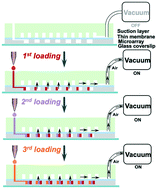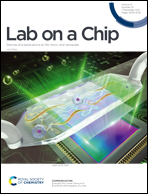A vacuum-assisted, highly parallelized microfluidic array for performing multi-step digital assays†
Abstract
There remains an unmet need for a simple microfluidic platform that can perform multi-step and multi-reagent biochemical assays in parallel for high-throughput detection and analysis of single molecules and single cells. In response, we report herein a PDMS-based vacuum-driven microfluidic array that is capable of multi-step sample loading and digitalization. The array features multi-level bifurcation microchannels connecting to 4096 dead-end microchambers for partitioning liquid reagents/samples. To realize multi-step repetitive liquid sample loading, we attach an external vacuum onto the chip to create internal negative pressure for a continuous liquid driving force. We demonstrated a high uniformity of our device for three sequential liquid loadings. To further improve its utility, we developed a thermosetting-oil covering method to prevent evaporation for assays that require high temperatures. We successfully performed digital PCR assays on our device, demonstrating the efficient multi-step reagent handling and the effective anti-evaporation design for thermal cycling. Furthermore, we performed a digital PCR detection for single-cell methicillin-resistant Staphylococcus aureus using a three-step loading approach and achieved accurate single-cell quantification. Taken together, we have demonstrated that our vacuum-driven microfluidic array is capable of multi-step sample digitalization at high throughput for single-molecule and single-cell analyses.



 Please wait while we load your content...
Please wait while we load your content...
